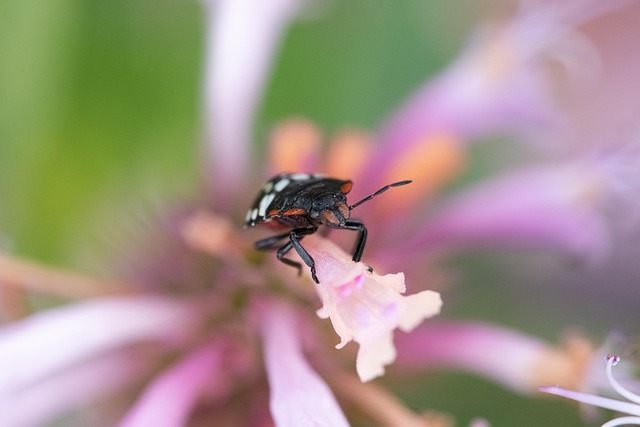Stink bugs, drawn to warmth, light, and food sources, often invade homes through cracks and dark spaces. To achieve effective residential stink bug treatment, homeowners should minimize attractants by managing humidity, storing food properly, cleaning regularly, and decluttering. A multi-step approach involving inspection, sealing entry points, cleaning, vacuuming, and using eco-friendly insecticides is recommended. Long-term prevention strategies like sealing entry points, regular cleaning, and yard maintenance significantly reduce the risk of stink bug invasions.
Stink bugs are a common pest issue, particularly in residential areas. If you’re dealing with these odorous invaders, understanding their behavior and habitat is key to effective control. This article offers professional advice on reducing stink bug attractants in your home. We’ll guide you through identifying common attractants, exploring powerful treatment strategies, and implementing preventative measures for long-term residential stink bug treatment success.
Understanding Stink Bugs: Behavior and Habitat
Stink bugs are a common pest in many residential areas, known for their ability to infiltrate homes and cause distress. Understanding these insects is the first step towards an effective stink bug treatment. Stink bugs have a unique behavior pattern; they prefer warm temperatures and often seek shelter in cracks, crevices, and dark spaces during the day, becoming active at night when they feed on plant juices and move from one location to another. Their preferred habitats include homes, schools, hospitals, and offices, making them a nuisance in various settings.
These pests are attracted to carbon dioxide, light, and heat, which is why they often gather near windows and doors during the evening. They also have a preference for certain plants, such as trees, shrubs, and vines, that provide easy access to their preferred food sources. By knowing their behavior and preferences, homeowners can better understand how to reduce stink bug attractants in residential areas, making it easier to implement effective stink bug treatment methods.
Identifying Common Stink Bug Attractants in Residential Settings
In residential settings, several factors can make a home more attractive to stink bugs. Common attractants include certain types of wood, such as those used in furniture or structural elements, as these insects are drawn to the moisture and organic compounds present in these materials. Additionally, stink bugs are often found in areas with high humidity, like basements, attics, or kitchens, where they can easily access food sources like spilled grains, pet food, or even the sweet residues left behind on dishes.
To implement effective residential stink bug treatment, homeowners should start by identifying and eliminating these attractants. This may involve using moisture-absorbing packets in damp areas, sealing gaps around windows and doors to prevent entry, and storing food properly to reduce spills. Regular cleaning and decluttering can also help, as it reduces hiding spots and makes it harder for stink bugs to find and settle in.
Effective Residential Stink Bug Treatment Strategies
When it comes to effective residential stink bug treatment, a multi-pronged approach is key. Starting with a thorough inspection to identify stink bug infestations and their sources is crucial. Once located, sealing entry points like cracks, gaps in doors and windows, and any other potential access points can prevent new bugs from entering your home. Regular cleaning and vacuuming, especially in areas where stink bugs congregate such as dark, quiet corners and under furniture, helps to remove eggs, nymphs, and adult bugs, breaking their life cycle.
Complementing these physical measures with a safe and eco-friendly insecticide can further enhance residential stink bug treatment. Look for products specifically designed for indoor use and follow label instructions carefully. Regularly treat affected areas, focusing on corners, baseboards, and other hiding spots. Additionally, maintaining a clean and clutter-free home reduces the places where stink bugs can hide and breed, making it a holistic part of your residential stink bug treatment strategy.
Preventative Measures: Long-term Solutions for Stink Bug Control
Preventative measures are key to long-term solutions for residential stink bug treatment. Sealing entry points such as cracks, gaps in doors and windows, and other potential access points can significantly reduce the risk of stink bugs invading your home. Regularly cleaning and vacuuming, especially in areas where stink bugs congregate like under furniture, in corners, and near walls, can also help deter them. Additionally, maintaining a clean yard by removing decaying vegetation and clutter provides fewer hiding spots and food sources for these pests.
Using a combination of these preventative measures can create an inhospitable environment for stink bugs, reducing their attraction to your home. This not only minimizes infestations but also eliminates the need for frequent pest control treatments, making it an effective long-term strategy for residential stink bug management.
Stink bugs can be a persistent pest in residential settings, but understanding their behavior and habitat is the first step towards effective control. By identifying common attractants and implementing tailored treatment strategies, homeowners can significantly reduce stink bug populations. Preventative measures, such as sealing entry points and maintaining a clean environment, offer long-term solutions for managing these insects. With the right approach, achieving and maintaining a stink-bug-free home is achievable, ensuring a more comfortable living space for residents. For comprehensive residential stink bug treatment options, consult professionals who can provide tailored advice and solutions.
